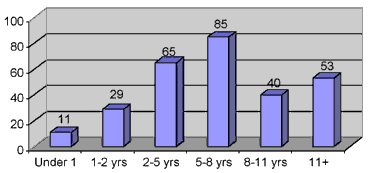Adoption Policy Review Group: phase one report
Report on phase one of a two-phase review to look at adoption law and practice, commissioned in April 2001.
ADOPTION POLICY REVIEW GROUP -REPORT PHASE I
INFORMATION ABOUT LOOKED AFTER CHILDREN AND ADOPTION |
ANNEX 7 |
Numbers of Looked After Children and Those Placed for Adoption
Numbers of Children Potentially Affected by Adoption
- Local authorities send information to the Scottish Executive each year about the numbers of 'looked after' children. Currently just over 11,000 children are 'looked after'. Around 3,000 of these are in foster placements. Just over 1,500 are looked after in residential homes and schools. The majority, 6,500 children, are with families or relatives.
- The chart below shows the trends in numbers and placing of 'looked after' children.
-
CHILDREN LOOKED AFTER AT 31 MARCH
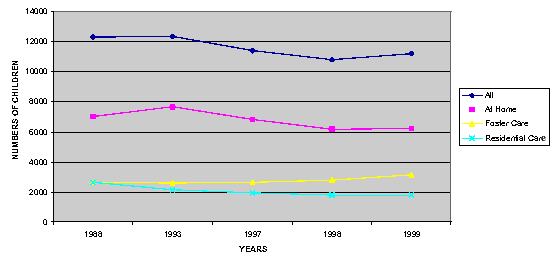
This shows a marked increase in children 'looked after' away from home, particularly in foster care. This would suggest a large demand for permanence away from the family home, some of which may be a need for adoption.
- Children become 'looked after' away from home ( see para 7 of Chapter 1) for many reasons. They may be made the subject of a supervision requirement by a Children's Hearing either on welfare or offence grounds. They may be the subject of a Child Protection Order. A warrant may be keeping them in accommodation. Often, they will not be away from home for very long, and/or the reasons may not be about their care and safety. It is clear that adoption will never be an option for many 'looked after' children.
Percentage of Children Looked After Percentage of Children Adopted From Care
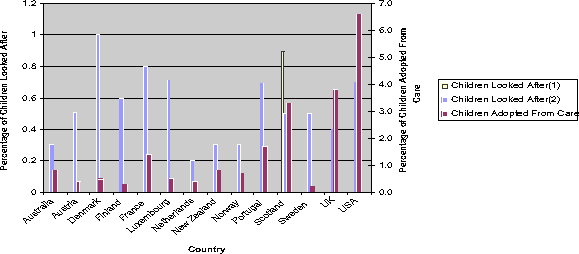
(1) all children(2) away from home
- The table above shows how Scotland compares internationally both on proportions of children 'looked after' away from home and on those 'looked after' children who are adopted.
- This shows that more children are adopted in America where policy favours adoption over other forms of permanence. Few children in EU countries are adopted as policy favours continuing links with birth families. Scotland is in line with the UK average for adoptions for children 'looked after' away from home. When compared internationally, a high proportion of children in Scotland are adopted.
- The BAAF Scotland (2001) Survey "Achieving Permanence for Children in Scotland - the Place of Adoption" provides baseline data on children awaiting adoption in 1999-2000. 30 out of 32 authorities responded to the survey. Of the 758 children awaiting permanence in 1999-2000:
- 61 were registered for adoption before April 1999 and not placed;
- 278 were registered for adoption in 1999-2000;
- 94 were registered for permanence such as foster care before April 1999 and not placed; and
- 325 were registered for other forms of permanence in 1999-2000.
Of these 758 children, 486 were placed in 1999-2000, leaving 272 children not placed - an increase on the previous year of 117.
TABLE 3
STATISTICS
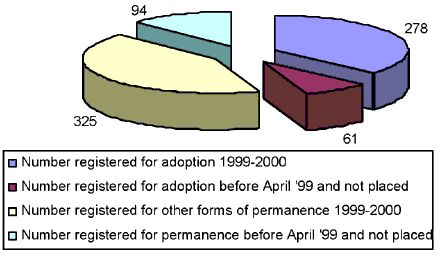
| TOTAL: |
758 |
| Total registered in 1999-2000 |
603 |
| Total brought forward |
155 |
| Total placed |
486 |
| Children not placed |
272 |
- This shows that there is an un-met and increasing demand for families to adopt children. More potential adopters are needed. There is likely to be further latent demand for adoptive families for children in the 'looked after' system for whom permanence has not yet been considered or for whom adoption was not addressed as an option. Adoption might be an option for some children currently placed for fostering.
- The group found evidence that the level of recruitment and approval for both prospective adopters (240) and families approved for long-term fostering (84) are not keeping pace with the number of children being registered.
- Less than half of children are placed with adopters recruited by their local authority.
-
The Nature of Children Awaiting Adoption
TABLE 4
STATISTICS
SOURCES OF PLACEMENTS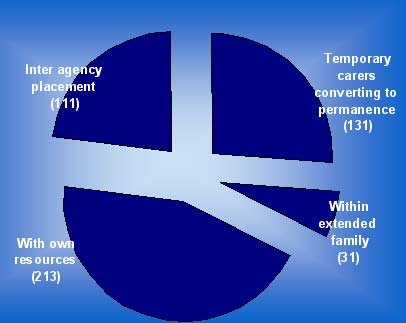
TOTAL: 486
The study also identified the age profiles of children placed for adoption and those awaiting adoption.
TABLE 7
Profiles of children placed or waiting.
Age Profile - Placed
-
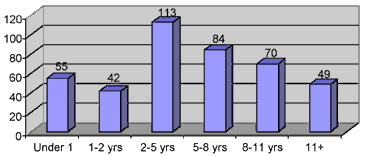
10.1 Waiting
- The above table illustrates that the age profile of children placed is considerably older than was historically the case, when many babies were relinquished and adopted.
- It also shows that it is easier to find families for younger children. Older children are more likely already to have faced much disruption, both within their birth families and in placement changes while in the 'looked after' system. In consequence they may already be very damaged, making them considerably more difficult to place and for an adoptive family to meet their needs. More birth parents have significant drug or alcohol related problems and their resulting chaotic lifestyles can cause great damage to their children. Children awaiting adoption are now more likely to suffer from health problems such as ADHD and may have mental health problems. Research in America shows that adoption outcomes can be successful for such children. It is, however, harder to find matching families for such children.
- Given that the outcomes of a childhood spent 'looked after' are so poor, and the fact that once children have been 'looked after' away from home for more than a year, they are likely to grow up 'looked after', a need for early permanence planning is shown. Since children are harder to place after the age of 5, it is particularly important to identify adoption as an option for permanence promptly for very young children and to avoid delays in the pre-matching process.
- Scottish children may be placed for adoption in sibling groups. There is no evidence to suggest that it is harder to place such children, especially for younger children. There is little or no information on sibling groups where younger children might be considered for adoption, whilst older children wish to retain links with birth family members.
- BAAF found in 1999-2000 that 12 children were placed from minority ethnic backgrounds, with 3 still waiting. The children were placed with adopters from minority ethnic backgrounds or mixed ethnicity. The sample was not of sufficient size to deduce if there are particular issues raised by minority ethnic adoption in Scotland.
There is a problem
Thanks for your feedback
